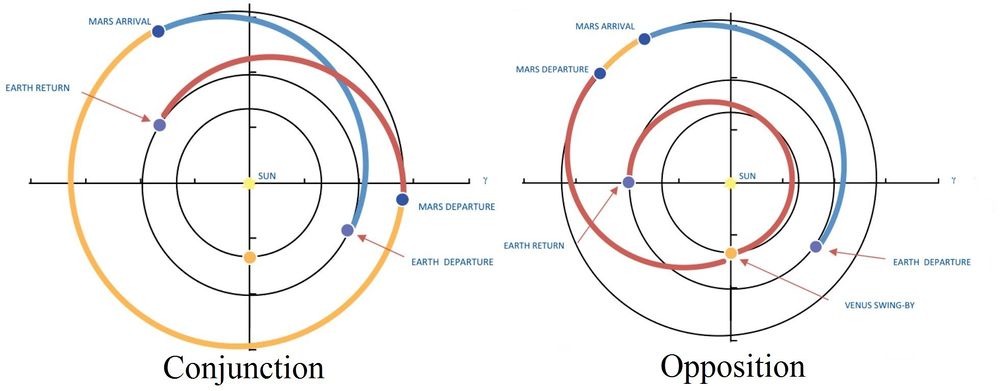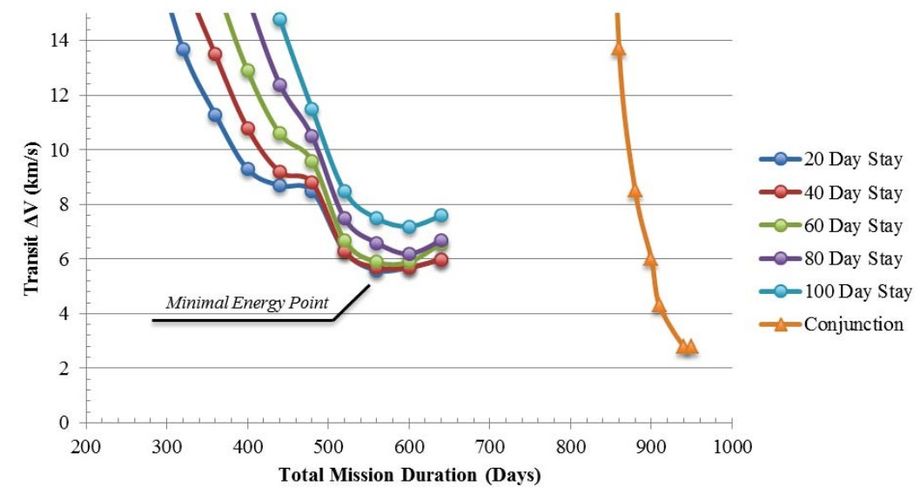Difference between revisions of "Mars mission duration"
| Line 67: | Line 67: | ||
==References== | ==References== | ||
<references /> | <references /> | ||
| + | [[Category:Mars Human Exploration]] | ||
Revision as of 06:21, 13 November 2020
Manned missions to Mars split in two different types. They are named after astronomical names of the moments of departure of the ships from Mars: conjunction and opposition. Opposition type mission have less total time but more time spent travel in weightless conditions, conjunction mission have much more time spent in Mars surface. Сonjunction and opposite mission type examples:
| Mission type [1] | Total mission duration, days | Earth-Mars trip, days | Time spent at destination | Mars-Earth trip, days | Total ∆V, km/s | Trans-Mars Injection, km/s | Mars Orbital Insertion, km/s | Trans-Earth Injection, km/s |
|---|---|---|---|---|---|---|---|---|
| Conjuction | 1005 | 198 | 558 | 197 | 2.81 | 0.50 | 1.25 | 1.06 |
| Opposition | 560 | 177 | 40 | 342 | 5.69 | 0.61 | 1.75 | 3.33 |
Mars have very elliptical orbit relatively to Earth. The eccentricity of the orbit of Mars is 0.0935 – second among the planets after Mercury. Launch windows to Mars opened approximately every 2.14 years (26 months) but because of Mars orbit eccentricity and differences in his orbital speed this time changes a little bit from time. The same way changes a distance between Earth and Mars in moment of oppositions, time travel to Mars and necessary for this delva-V.
The required parameters change at intervals of 15-17 years[2].
Examples of the near-future missions opportunities:
Mars short-stay (opposition) mission
| Departure Date [3] | Mission Duration (years) | Time spent at destination | Injection (C3/∆v), km/s | Post-escape ∆v, km/s | Destination Aerocapture (∆V/Inertial), km/s | Earth Aerocapture (∆V/Inertial), km/s |
|---|---|---|---|---|---|---|
| 19-Jul-2020 | 1.50 | 1 month | 14.5/3.87 | 2.80 | 1.41/6.2 | 0.86/11.8 |
| 22-Oct-2021 | 1.39 | 1 month | 14.4/3.86 | 2.80 | 3.48/8.2 | 0.47/11.4 |
| 14-Sep-2023 | 1.64 | 1 month | 25.7/4.34 | 0.99 | 3.29/8.0 | 0.48/11.4 |
Mars long-stay (conjunction) mission
| Departure Date [3] | Mission Duration (years) | Time spent at destination | Injection (C3/∆v), km/s | Post-escape ∆v, km/s | Destination Aerocapture (∆V/Inertial), km/s | Earth Aerocapture (∆V/Inertial), km/s |
|---|---|---|---|---|---|---|
| 4-Aug-2020 | 2.53 | 1.40 years | 15.7/3.92 | 1.45 | 0.70/5.5 | 0.80/11.7 |
| 15-Sep-2022 | 2.63 | 0.85 years | 14.4/3.86 | 0.94 | 0.88/5.6 | 0.50/11.4 |
| 14-Oct-2024 | 2.62 | 0.87 years | 12.1/3.76 | 0.82 | 0.73/5.5 | 0.58/11.5 |
For reducing crew time exposure to weightless, interplanetary radiation and the risk of being hit by solar flare it is possible to use increasing delta-V. For some of these variants it is possible to use the option of free-return trajectory - trajectory with ability return back to Earth with small amount of delta-V spending safe if the main spacecraft engine will fail to start. Options for free-return trajectories[4]:
| Departure Velocity, km/s | Orbit Period, years | Time to Earth Return, years | Transit to Mars, days | Mars Aeroentry possibility |
|---|---|---|---|---|
| 3.34 | 1.5 | 3.0 | 250 | Easy |
| 5.08 | 2.0 | 2.0 | 180 | Acceptable |
| 6.93 | 3.0 | 3.0 | 140 | Dangerous |
| 7.93 | 4.0 | 4.0 | 130 | Impossible |
References
- ↑ Bryan Mattfeld, Chel Stromgren - Trades Between Opposition and Conjunction Class Trajectories for Early Human Mission to Mars in AIAA Space 2014; 4-7 Aug. 2014; San Diego, California
- ↑ L.E. George, L.D. Kos - Interplanetary Mission Design Handbook: Earth-to-Mars Mission Opportunities and Mars-to-Earth Return Opportunities 2009-2024 in NASA Center for AeroSpace Information July 1998; Linthicum, Maryland
- ↑ 3.0 3.1 Cyrus Foster, Matthew Daniels - Mission Opportunities for Human Exploration of Nearby Planetary Bodies in AIAA SPACE 2010 Conference & Exposition, 30 August - 2 September 2010, Anaheim, California ISBN AIAA 2010-8609
- ↑ Robert Zubrin - The Case for Mars: The Plan to Settle the Red Planet and Why We Must in Touchstone, 1996, New York.










